In the United States, school calendars have long followed the same pattern: 9-month school years with a few short breaks throughout, and a long summer break lasting up to 12 weeks. But the United States is actually a bit of an outlier when it comes to school schedules. Many other countries follow a year-round school calendar instead. Some feel the United States should follow suit, claiming year-round schooling would minimize summer learning loss, among other benefits. So, what does year-round school look like, and what are the pros and cons?
We took a deep dive into this divisive topic to find out more. We also talked with a teacher from a year-round school for a real-life perspective. Rebecca Luna has been teaching for 25 years, in both traditional and year-round settings. She currently teaches 1st grade at a multi-track year-round school (Rondo School of Discovery, a part of Corona-Norco Unified School District in California). She shared her thoughts on a variety of topics related to non-traditional school calendars.
What is year-round school?
In a year-round calendar, breaks are spread more evenly throughout the school year. Students still attend school for around the same number of days (most states mandate a minimum of 180), and in most cases still get a longer break in the summer. The calendar does take holidays (such as Labor Day and Thanksgiving) into account, as well as providing no-student days for teacher in-service. Below are some of the more common calendars.
Year-Round School Calendar Examples
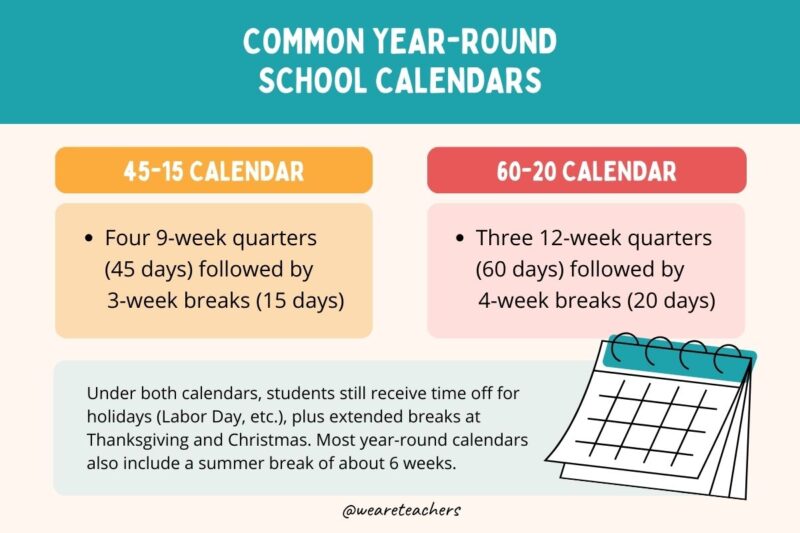
45-15 Calendar
This is probably the most common option, with 45 instructional days followed by 15 days off. This is ideal for schools on a quarter system, since the long breaks fall at the end of each quarter. Summer break is a little longer, at about six weeks.
Here’s an example calendar, used by Longfellow Elementary in Rochester, New York.
- School days: July 24 – September 27
- Fall Break: September 30 – October 18
- School Days: October 21 – December 20 (3 days off for Thanksgiving)
- Winter Break: December 23 – January 10
- School Days: January 13 – March 14
- Spring Break: March 17 – April 4
- School Days: April 7 – June 6
- Summer Break: June 9 – July 23
60-20 Calendar
The school year is broken into three sessions of 60 instructional days (12 weeks) each, followed by 20-day breaks (around a month). Essentially, students attend school for around three months, followed by a one-month break. This is the most evenly distributed of all the school calendars and may be the most ideal for minimizing learning loss.
Here’s an example from an elementary school in California:
Session 1:
- School days: July 10 – September 29
- Month Off: September 30 – October 29
Session 2:
- School Days: October 30 – December 22 (2 days off for Thanksgiving)
- Winter Break: December 23 – January 7
- School Days: January 8 – February 2
- Month Off: February 3 – March 3
Session 3:
- School Days: March 4 – May 24
- Summer Break: May 25 to July 8
Multi-Track Year-Round Schedules
When schools have more students than they can accommodate, they may use a year-round (often 60-20) multi-track schedule. In these cases, students and teachers are broken into “tracks,” each following their own schedule. During the time when one track is not in school, another track uses their classroom space and learning resources.
“Our school calendar runs on a 12 weeks on and 4 weeks off schedule,” Rebecca explains. “And everyone still gets to enjoy a 2-week winter break in between. We have four tracks, A,B,C & D. My schedule is B track, so I teach August to October, December to February, and April to June. My months off track are July, November, and March.” At the end of each session, she and her students move to a different classroom.
“We have a busy schedule with moving from one classroom to another every four months, but on the positive side, our teachers are organized and don’t hold onto to useless belongings,” Rebecca points out. ” We keep the most useful and up-to-date curriculum and decor for our beautiful school.”
It works for students, too. “The students make very close friendships and bonds with their ‘on track’ peers. Students must be held accountable for their belongings as they travel from room to room every four months. They keep their folders, cubbies, and other areas organized to maximize their learning.”
Pros and Cons of Year-Round School
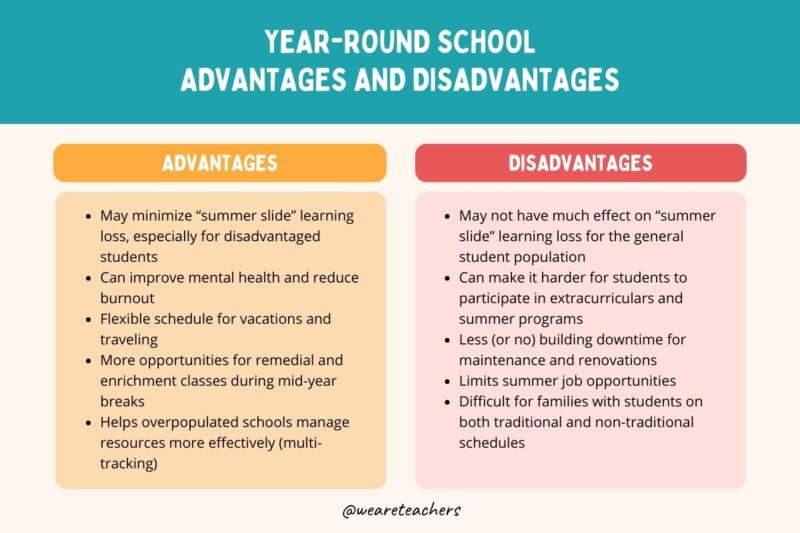
Wondering if these calendar shifts are really worth the trouble? You’re not alone. Though year-round school is very common in other countries, the United States has generally been resistant to the change. Take a closer look at some of the year-round school pros and cons.
Does year-round school minimize learning loss?
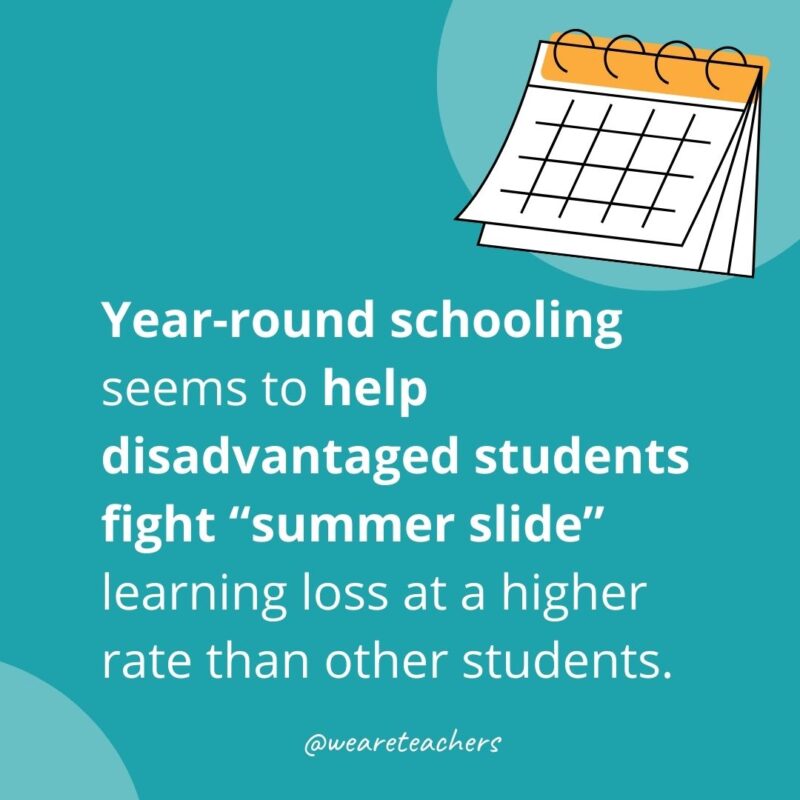
This is usually the biggest argument in favor of a more even calendar: the chance to fight summer slide. While there’s some debate as to the real impact summer learning loss has on students, research supports the concept. One study found that students in grades 1 through 8 lose 17% to 34% of the prior year’s learning over summer break.
If a long break leads to learning loss, logic says shorter breaks should help prevent that slide. But is that true? Studies on the topic seem to vary in their conclusions. Generally, it seems that year-round schooling has the most benefit for disadvantaged students, such as those of low socioeconomic status or students with special needs. In other demographics, year-round school seems to have a minimal effect on summer learning loss.
In schools like Rebecca’s, the year-round calendar has been a benefit. “Students get a break after every 12 weeks. This break is only 4 weeks, so the gap in losing what they have learned is very minimal,” she notes. “Most of the time, we pick up right where we left off and have no issues with curriculum and routines review.”
Can year-round school benefit mental health?
Student and teacher anxiety levels are at an all-time high, and it’s possible year-round school could help. More evenly spaced breaks give everyone time to relax throughout the year. “The schedule provides such a positive mindset when it comes to needing a break,” Rebecca says. “We know that there is one just a few weeks away!” Though there aren’t a lot of studies into the effects of year-round calendars on mental health, this could be a promising way to combat the stress and anxiety many students and educators face.
Does year-round education affect student absenteeism?
Studies have found that schools on a year-round calendar actually experience lower rates of student absence. This may be in part because families have more frequent opportunities throughout the year to plan travel, reducing the risk of them pulling their students out for midyear breaks (a small but significant factor for chronic absenteeism). But students at these schools also demonstrate better attitudes toward school in general, and are less likely to drop out.
Interestingly, several studies have noted that schools using non-traditional calendars also show lower absence rates among teachers. One study indicated that teachers at these schools have a better attitude, and while they may be slightly more stressed when school is in session, their overall burnout rate is lower. And year-round schools are more likely to retain teachers from one year to the next (possibly because of those lower burnout rates).
What other benefits does year-round schooling provide?
One benefit many year-round families and teachers enjoy is the ability to plan travel and other vacation activities during off-peak months. “Most of us love having the ‘not-so-busy months’ of the year to do our traveling,” Rebecca affirms.
Many year-round schools use those more frequent breaks as a chance to provide remedial classes and sessions. By providing extra support throughout the year, schools can help struggling students from falling further and further behind. They may also offer enrichment opportunities that keep students engaged and involved in school, even during breaks.
Year-round calendars can also help schools manage resources more effectively. “Our school’s population is currently a little over 1,200 students, and the building can only hold about 800 students at a time,” explains Rebecca. A 60-20 calendar multi-track schedule allows this school to make full use of its classrooms and resources year-round.
What are the arguments against a year-round school calendar?
There are a lot of good reasons to consider a year-round option, but there are drawbacks too. These are some of the objections people raise when the concept of year-round school arises.
Harder to participate in summer programs and non-school extracurriculars
If a school is the only one in its area on a non-traditional calendar, families may find it difficult to participate in activities that are planned around traditional school times. For instance, kids may not be able to attend summer camps if their schedule keeps them in school during those months. They may also find it harder to participate in community sports, clubs, and other activities.
Makes school building upkeep more challenging and expensive
Some point to increased costs, especially in multi-track systems where school buildings are essentially in use nearly every week of the year. These buildings require more heating and cooling expenses, and they must employ custodial staff year-round too.
Schools often use the long summer breaks to take care of extended maintenance and renovation projects that they can’t do when school is in session. Even when all students and staff are off for a six-week summer break, this still may not be enough time to take care of those projects.
Families may have students on different schedules
While some districts have converted all their schools to non-traditional schedules, others use it only for certain grades or school buildings. That means a family could easily wind up with an elementary student on a 45-15 schedule and a high schooler with a traditional calendar. Planning childcare can become a real problem, as well as coordinating transportation and extracurriculars.
May limit summer job opportunities
Lots of high school students take advantage of a long summer break to earn some extra cash and begin building up work experience. But employers may be less likely to hire students who can only work six weeks, since by the time they’ve trained them, they’ll be headed back to school. Students might be able to arrange to work during their longer midyear breaks, but not all businesses need the help at those times. This could also be a problem for teachers who take on second jobs during extended summer breaks.
Year-Round School Myths and Facts
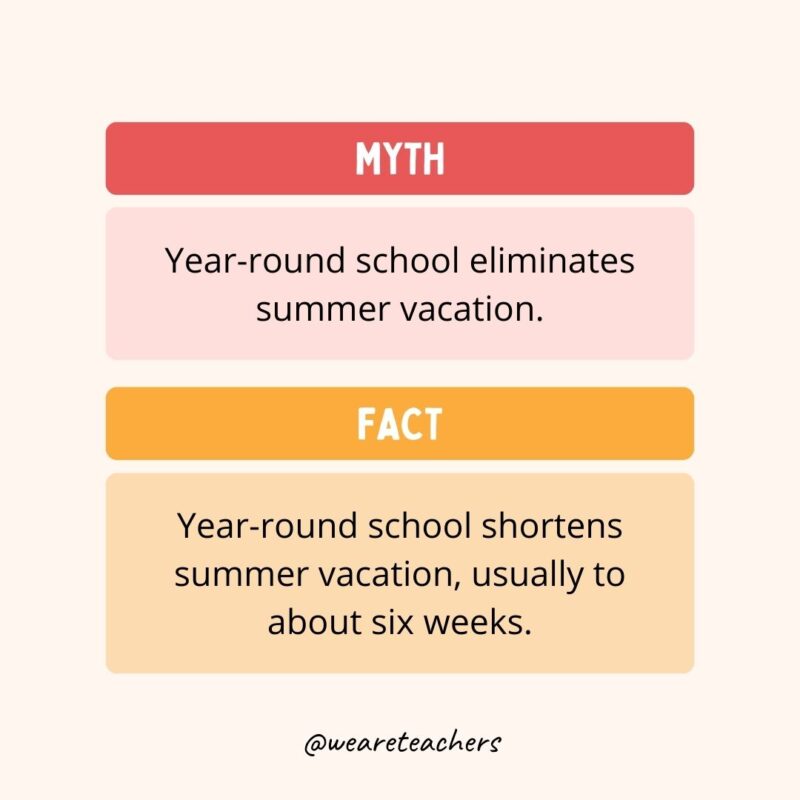
There are a lot of misconceptions out there around what “year-round school” really means. Consider these common beliefs, and learn the facts behind them.
Myth or Fact? Year-round school eliminates summer vacations.
Myth! It’s more accurate to say “Year-round school shortens summer vacations.” In the most common calendars, students and teachers still get around six weeks off each summer. That’s plenty of time to plan family vacations or participate in summer activities.
Myth or Fact? There are more instructional days in a year-round school calendar.
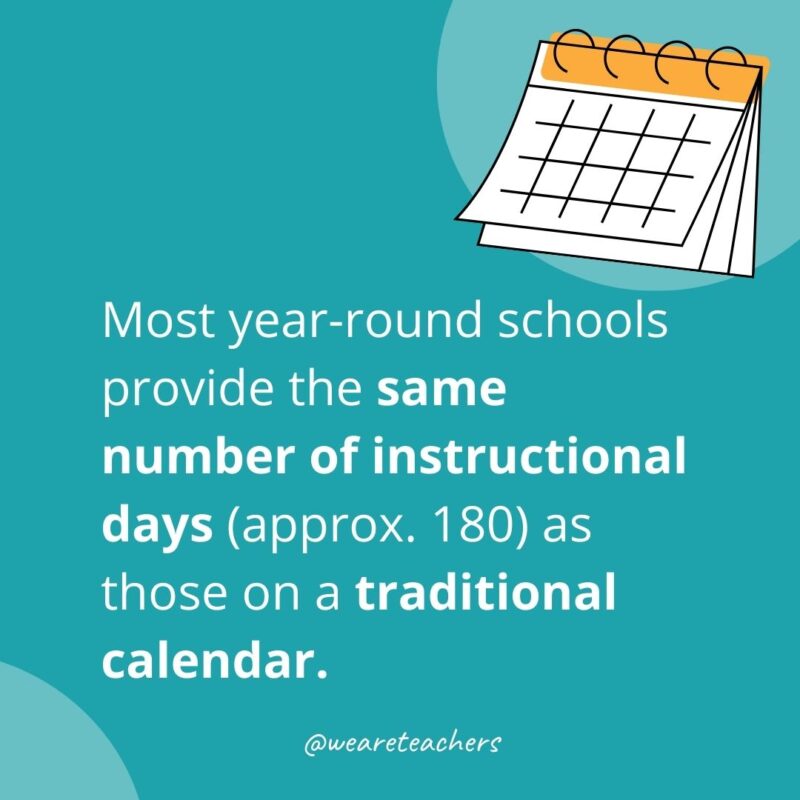
Myth! Year-round schools usually have around the same number of instructional days (most states require 180). They’re just more evenly distributed throughout the year. What a year-round calendar may provide is more frequent opportunities for remedial instruction during midyear breaks, but participation is usually optional.
Myth or Fact? Year-round school is a hassle for families.
It all depends on the family. When all their students are following the same year-round calendar, families actually tend to like the non-traditional school year. A study determined that “a strong majority of parents will favor a well-implemented YRE [year-round education] program and a minority of parents will resist any YRE program.”
Myth or Fact? Every community would benefit equally from year-round school.
Myth, most likely. Research seems to indicate that if your goal is to eliminate learning loss, year-round school has the most benefit for disadvantaged students. So if your school has a high population of students with lower socioeconomic status or disabilities, year-round school may help.
However, minimizing learning loss isn’t the only factor in the decision. A non-traditional calendar can be an excellent solution for schools who need to stretch their resources to accommodate a larger student population. It may also create a schedule that’s better for mental health or family travel opportunities. Ultimately, each school and district has to decide for themselves if year-round calendars are the right choice.
“I most definitely would work at a year-round school the rest of my career!” concludes Rebecca. “Year-round schools need teachers that are flexible, independent, and problem-solvers themselves to continue to give our community the very best in education.”

